IAI displayed a new member of its laser guided weapons family – the FireBall mortar munition, which offers extended range and high precision attack capability for 81mm and 120mm mortar teams. IAI also displayed the Lahat missile, in a quad launcher version, in both 105mm and 120mm versions. The Spike ER missile was also displayed by the IDF ground forces command, as well as by RAFAEL, in its new network centric Spike C4I version. This integrated Tactical C4I network was developed by RAFAEL to support the tactical operation of anti-tank / precision attack units equipped with the Spike LR/ER missile missile. The system can integrate various sensor platforms including individual sights of the anti-tank weapons, UAVs and other airborne sensors, acoustic sensors and observation posts.
LIC – 2004 review – Infantry Weapons
Among the infantry systems on show at LIC 2004 were many improvements to existing weapon, and new systems under development in response to GCS requirements. One such system is the Refaim, under advanced development at IMI. The system was originally developed for the IMI Tavor assault rifle but was also modified to become modular and fit on other weapons, such as the Colt M-4.
The system utilizes International Technologies Lasers (ITL) MPRS infantry fire control system which can fire three different submunitions – an airburst grenade, a CS grenade and an observation grenade. Elbit has demonstrated a sophisticated Sniper Control System, developed by Eyerec, to facilitate the integration and control of accurate sniper fire in the conduct of MOUT operations.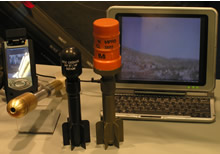
Utilizing the same components, Eyerec offers simple but effective capability to enable both guns and handguns to be used to fire “around the corner”, while the shooter maintains a safe position behind the obstacle. different system relying on dedicated weapon system is proposed by CornerShot. The system uses a wearable computer for display, or utilizes ITL’s new Situational Orientation System (SOS) commander’s integrated display binoculars for orientation.
RAFAEL displayed several types of weapon systems designed specifically for MOUT. Two breaching devices, including the Simon door breaching system and Shoulder Launched Wall Breaching Stand-off Munitions, which can be deployed from a tripod or shoulder fired. The system can breach a man size hall in a triple brick wall, from a distance of 20 meters.
The Personnel Network Radio PNR-500 from Tadiran Communications is designed to provide communications between infantry team members, over a very short range (up-to 800 meters). When such devices are distributed to all the troops of an infantry squad, these sets enable the squad leader to control his teams more effectively and quietly, while facilitating external communications to the company and other external networks.
Elbit also demonstrated the “Infantry 2000” concept program, currently underway as part of the IDF future concept study. A similar program underway at ITL is studying the various aspects of an infantry combat suite optimized for urban warfare.
Powering the Land Warrior
Start < Page 1 of 5 >
Battery power, rather than fire power, is rapidly becoming a major factor in military planning, as the electronics that power modern and future systems are becoming more sophisticated, complex and reliant on portable battery power. As the need for electrical power is growing, so does the total weight of power sources – a growing component of the soldier’s load is the primary and backup power sources for individual systems – communications, navigation, imaging, computation, sensors, etc. The logistics burden of supplying power to the battlefield is also growing and becoming more complex, due to lack of battery standardization and unification. For example, as operation Iraqi Freedom opened, batteries were in very short supply, as troops in the south of Iraq used half of the projected total war requirements in only a few days. 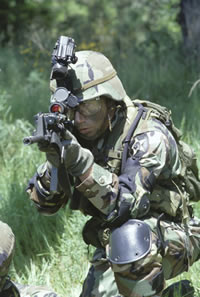 Supplies to combatants in the North of Iraq were unavailable. Forward stocks of batteries drained during the first days of the hostilities and the entire supply of the US Army was to be used up in two months, if not replenished under an emergency program. Batteries had to be airlifted from US depots to Iraq and round the clock production of new inventories had to be initiated with six manufacturers worldwide.
Supplies to combatants in the North of Iraq were unavailable. Forward stocks of batteries drained during the first days of the hostilities and the entire supply of the US Army was to be used up in two months, if not replenished under an emergency program. Batteries had to be airlifted from US depots to Iraq and round the clock production of new inventories had to be initiated with six manufacturers worldwide.
Today’s need for electrical power on the battlefield is high and continues to grow. Unless sources of power evolve with the systems that use them, they will create a logistics and tactical burden for the soldier. Because new power-consuming systems quickly are becoming an integral part of the way the Army plans to fight, better ways must be found to support power requirements. Initiatives have been started to save money on batteries in the long term and to enable combat and materiel developers to reduce expenses early in a product’s life cycle. Power sources must be an important consideration in all future materiel and combat developments. As soldiers expect more out of the equipment they use, they must expect more from their power sources.
Additional Parts of this article :
- Powering the Land Warrior
- Military use of Primary Lithium Batteries
- Rechargeable Power For Military Use
- Logistic Aspects of Military Batteries
- Logistics of Military Rechargeable Battery
Precision Guidance Concepts
The employment of different types of seekers enables planners to take advantage of environmental or man-made effects, such as the use of electronic deception, various obscurants or difficult weather conditions. This capability was proven during OIF, when a heavy dust storm erupted over Iraq. It was spotted by weather satellites well before it reached the area. The ability to predict its effects and duration were realized by the US operational planners; they shifted more non visual assets including electronic based sensors (SAR/GMTI), such as Joint STARS Synthetic Aperture Radar (SAR) aircraft, Rivet Joint SIGINT electronic intelligence platform, and the Global Hawk high altitude UAV to continue and track the Iraqi forces. While the Iraqis tried to move their forces to reinforce the Medina Division south of Baghdad their communications and movements were spotted and accurately located by SIGINT and Ground Moving Target Indicator (GMTI) sensors and could be engaged by radar- and GPS-based weapons, such as Longbow, JDAM and other assets which are designed to operate under all weather conditions.
Precision Strike Guidance Technologies:
| Technology | Key features |
| Semi Active Laser Homing | Very high precision, vulnerable to weather & countermeasures |
| Electro-Optical (VIS / IIR) | Autonomous, flexible retargeting with datalink |
| GPS /IMU | Autonomous, all weather |
| Scene Matching (EO) | Autonomous, pasive |
| Terrain Mapping | Autonomous |
| Active Radar / MMW Radar | Autonomous, engagement of selective moving targets engagement, all weather capability |
| LADAR | Flexible targeting, Autonomous, selective targeting |
Additional parts of this article:
- Precision Strike Weapons
- Precision Strike Concepts
- Transformation of Air Strike Operations
- Net Centric Precision Strike Weapons
- Battle damage Assessment Capabilities
- Precision Strike Systems
- Precision Guidance Concepts
- Modern Bombers Applications for Conventional Warfare
- Precision Attack in Urban Warfare
LIC 2004 – Less than lethal weapons
 Other exhibits focused on the employment of less than lethal weapons. Such systems are developed by IMI, including Stun Cartridges (SC) for 120mm tank guns, which enables tanks to use their main the armament in complex MOUT situations, reducing collateral damage. Other types of grenades presented here were CS rifle grenades which enable infantry to deploy CS at twice the range of existing hand grenades and mortars. Various types of multi-effect CS grenades and “Sprinkler” type CS canisters were also unveiled by Ispra, as part of their arsenal of less than lethal crowd control systems.
Other exhibits focused on the employment of less than lethal weapons. Such systems are developed by IMI, including Stun Cartridges (SC) for 120mm tank guns, which enables tanks to use their main the armament in complex MOUT situations, reducing collateral damage. Other types of grenades presented here were CS rifle grenades which enable infantry to deploy CS at twice the range of existing hand grenades and mortars. Various types of multi-effect CS grenades and “Sprinkler” type CS canisters were also unveiled by Ispra, as part of their arsenal of less than lethal crowd control systems.
A different concept for a non lethal crowd control was demonstrated by EROD. The company developed an acoustic phased array system which can incapacitate humans from a standoff range, by applying high power acoustic load. The system can be mounted on a tactical vehicle, and radiate a narrow, high power steerable acoustic beam, disorientating humans. The high power is inflicted on the target by coherent superposition of the acoustic outputs from 36 horns. Both horizontal and vertical beams can be formed simultaneously to create a point effect within buildings.
LIC 2004 – Homeland Security
everal Israeli companies are focusing many efforts at the newly established buffer zone, (erroneously known as the “wall” separating occupied territories controlled by the IDF, as well as some Palestinian Authority managed regions from Israeli territory. Many companies have developed systems for the protection, surveillance and defense of this obstacle. Two are constructing the obstacle system – Magal Security Systems, which already constructed 140 km of the buffer zone in the Northern and Central region, and Elbit Systems, which is currently extending it into a section cordon, around Jerusalem. Magal is currently offering to enhance the basic sensors of the fence with video cameras integrated in every segment. A different concept is the EO passive radar system, promoted by Magna Ltd., developers of a passive radar system, based on stereoscopic video motion detection system. Such systems can effectively provide early warning on suspicious activities within the sterile zone and beyond. Other systems, such as ground surveillance radars can provide similar coverage, even under adverse weather conditions, but at higher cost. A covert, passive device designed to detect human activity is the “Virtual Fence” sensor array, combining acoustic, seismic and IR sensors. This unattended, covert sensor array can detect, locate, and identify human or vehicular activity over a large protected area. Another type of sensor, the Unattended Ground Sensor (UGS), developed by Seraphim is already deployed by the IDF and has recently been tested by the USAF. 
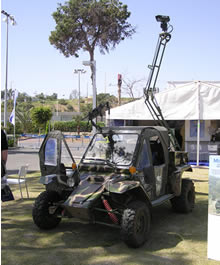 Elbit has demonstrated a wide variety of systems designed for operation in the buffer zone. These include various long-range observation systems, including the LOROS system, which is widely used in the IDF, the Lotus G thermal observation system, capable of identification of targets at ranges beyond 20km, as well as mobile platforms, such as the Mil-Tomcar rapid response all terrain vehicle, which is fitted with an elevated EO payload and communications equipment, transmitting images to sector command center. Elbit is also proposing the tethered aerostat developed by TopiVision, as a surveillance system which can be pre-positioned at specific points or transported to fill temporary “gaps”. The aerostat was used extensively in several incidents supporting for the Israeli police, and is currently equipped with a stabilized EO payload offering x100 power zoom.
Elbit has demonstrated a wide variety of systems designed for operation in the buffer zone. These include various long-range observation systems, including the LOROS system, which is widely used in the IDF, the Lotus G thermal observation system, capable of identification of targets at ranges beyond 20km, as well as mobile platforms, such as the Mil-Tomcar rapid response all terrain vehicle, which is fitted with an elevated EO payload and communications equipment, transmitting images to sector command center. Elbit is also proposing the tethered aerostat developed by TopiVision, as a surveillance system which can be pre-positioned at specific points or transported to fill temporary “gaps”. The aerostat was used extensively in several incidents supporting for the Israeli police, and is currently equipped with a stabilized EO payload offering x100 power zoom.
Several companies are offering dedicated the sensors for the buffer zone. RAFAEL is promoting its proven TACS system, which is already operational along Israel’s Northern border with Lebanon. The system uses a variety of airborne, ground mounted, and unattended sensors to provide a tightly integrated security zone designed to defeat any infiltration through the border or meditarranean coastline.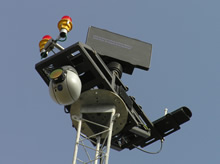
IAI Elta is also offering a comprehensive range of surveillance systems, installed on airborne or tethered platforms, mast mounted mobile, or based on observation towers. The sensors comprise of an integrated surveillance system, including EO payload, ground surveillance radar and digital compass.
DEFEXPO 2004 – Homeland Defense
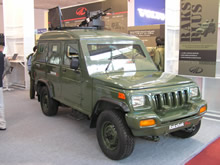 Mahindra, the large Indian vehicle manufacturer unveiled its Striker lightweight high mobility combat vehicle, designed for armed reconnaissance and mounted patrols. The vehicle was displayed mounting four Milan missiles and a 7.62 mm machine gun. Mahindra also exhibited the Rakshak Plus, a protected vehicle designed for rapid reaction teams, mounted patrols and transportation of commanders and VIP. Rakshak Plus utilizes interchangeable armor protection plates designed to stop multiple 7.62mm hits. The protection suite consisting of hardened steel, high performance polyethylene and aramid laminates and bullet proof glass. The protection suite was designed by Plasan Sasa.
Mahindra, the large Indian vehicle manufacturer unveiled its Striker lightweight high mobility combat vehicle, designed for armed reconnaissance and mounted patrols. The vehicle was displayed mounting four Milan missiles and a 7.62 mm machine gun. Mahindra also exhibited the Rakshak Plus, a protected vehicle designed for rapid reaction teams, mounted patrols and transportation of commanders and VIP. Rakshak Plus utilizes interchangeable armor protection plates designed to stop multiple 7.62mm hits. The protection suite consisting of hardened steel, high performance polyethylene and aramid laminates and bullet proof glass. The protection suite was designed by Plasan Sasa.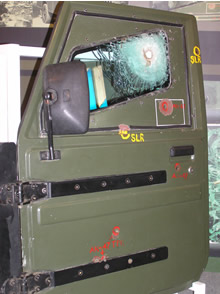
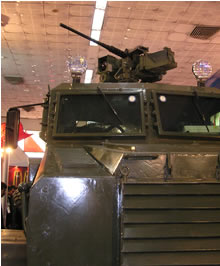 Another vehicle displayed by Mahindra is the Mobile Multi-sensor Surveillance System (MMSS), developed under cooperation between Mahindra, IAI/Elta and Esc Baz of Israel. The system is designed to operate as unattended ground sensor, transmitting surveillance data and images back to a regional command and control center. The vehicle can be equipped with a wide range of sensors, including the IAI/Elta integrated multi-sensor payload, utilizing the POP stabilized EO payload containing a color CCD, cooled thermal imager and a laser rangefinder package, the EL/M-2129 ground surveillance radar (or similar derivatives, locally built in India) and the Comet electronic compass. Another option is the Controp CEDAR IR automatic intruder detection system. Cedar was recently selected for the protection of the Olympic park in Athens, during the 2004 Olympics. Another low cost solution was also provided by Esc Baz from Israel, integrating a remotely controlled color day camera and uncooled thermal camera with a laser pointing device. Esc Baz officials at Defexpo told Defense Update that similar systems are already used for the protection of elements along the Israeli buffer zone and security perimeters around some isolated civilian settlements.
Another vehicle displayed by Mahindra is the Mobile Multi-sensor Surveillance System (MMSS), developed under cooperation between Mahindra, IAI/Elta and Esc Baz of Israel. The system is designed to operate as unattended ground sensor, transmitting surveillance data and images back to a regional command and control center. The vehicle can be equipped with a wide range of sensors, including the IAI/Elta integrated multi-sensor payload, utilizing the POP stabilized EO payload containing a color CCD, cooled thermal imager and a laser rangefinder package, the EL/M-2129 ground surveillance radar (or similar derivatives, locally built in India) and the Comet electronic compass. Another option is the Controp CEDAR IR automatic intruder detection system. Cedar was recently selected for the protection of the Olympic park in Athens, during the 2004 Olympics. Another low cost solution was also provided by Esc Baz from Israel, integrating a remotely controlled color day camera and uncooled thermal camera with a laser pointing device. Esc Baz officials at Defexpo told Defense Update that similar systems are already used for the protection of elements along the Israeli buffer zone and security perimeters around some isolated civilian settlements.DEFEXPO 2004 – Armor & Anti-Armor
Many Russian companies participated as part of the Rosboronexport pavilion. Among the participants was Electro Machina, state company, which demonstrated advanced systems for tank upgrading, including the Shtora-1 system, believed to be part of the Indian T-90 program. KBP presented an active armor protection solutions, including the Drozd. Other modernization programs are offered for the Russian BMP-3 by Kurganmashzavod. Further upgrading options were discussed by Mahindra, which is collaborating with Kinetics for the integration of Climate Control Systems (CCS) and Life Support Systems (LSS) for the new T-90 tank and BMP-2.Other improvements proposed include the installation of missile/gun systems such as the Kuliver, on troop carriers such as the BTR-80 and BMP series vehicles. This turret combines the firepower of the 2A27 automatic gun with the range and long range precision of the Kornet-E missile.
The Russian Artem company displayed the COMBAT anti-tank laser beam riding missile, which can be fired through the 125mm gun of the T-80UD, T-84, T-72AG, B and C models.
 A modernization program for T series tanks was also highlighted by KBP. The improvements enable day/night operation at extended range, firing of ammunition and missiles on the move, automatic tracking which improves target handling by 3 – 6 times, compared to manual track – and improved gunnery techniques. The system includes an improved the fire control system, gun stabilization and ballistic computer, and installation of separate gunner and commander’s sights. The introduction of new optics enable the use of gun fired laser beam riding anti-tank missiles, such as the 9M117M1 missile (for 115mm guns) and 9M119M missile (for 125mm guns). The missiles use semi automatic line of sight (SACLOS) Radio Frequency (RF) guidance and can hit targets at maximum range of 5 – 6km penetrating up to 950mm of ballistic steel. Previous versions of this munitions included the 9K112 Kobra (also designated AT-8 Songster NATO code).
A modernization program for T series tanks was also highlighted by KBP. The improvements enable day/night operation at extended range, firing of ammunition and missiles on the move, automatic tracking which improves target handling by 3 – 6 times, compared to manual track – and improved gunnery techniques. The system includes an improved the fire control system, gun stabilization and ballistic computer, and installation of separate gunner and commander’s sights. The introduction of new optics enable the use of gun fired laser beam riding anti-tank missiles, such as the 9M117M1 missile (for 115mm guns) and 9M119M missile (for 125mm guns). The missiles use semi automatic line of sight (SACLOS) Radio Frequency (RF) guidance and can hit targets at maximum range of 5 – 6km penetrating up to 950mm of ballistic steel. Previous versions of this munitions included the 9K112 Kobra (also designated AT-8 Songster NATO code).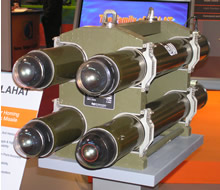
Another laser guided system displayed here was the Lahat, designed by IAI/MBT. This laser homing projectile can be fired at targets designated by the firing tank or any other source (UAV, infantry or helicopter) therefore, enabling the firing platform to disengage immediately after firing. Lahat can hit targets well beyond the range of conventional tank ammunition. The new missile recently passed field tests and live firing from Arjun tanks in India, and IAI has signed an agreement for local production of the missile. The Indian Army expects to take delivery of all 124 Arjun units on order, by early 2006.
Lahat missiles are designed for 105 and 120mm guns, and can also be accommodated with 125mm guns. The system was displayed in the tank gun configuration, as well as in its a lightweight quad launcher, which can be carried on ground vehicles, helicopters, as well as light aircraft or UAVs.
DEFEXPO 2004 – Artillery Systems
Artillery systems captured significant attention at the exhibition. Improvements for the Bofors FH77 currently in Indian service were presented by SWS Defense the company was willing to discuss some details about its proposal for the modernization of the 155/52 howitzer and the FH55BW autonomous, mobile (truck based) version. Soltam is currently converting Indian M-46 artillery to M-46S standard and is also competing on the upcoming Indian procurement tender for towed, autonomous gun systems. For this program Soltam proposed for this program the autonomous ATHOS 2052 155mm /52 cal system. the company also offers a truck mounted artillery version – ATMOS which was recently chosen for the ATROM program in Romania. South African Denel which is also competing for the lucrative Indian program was also represented with a broad range of artillery systems. The company displayed the Condor T-5 155mm/52Cal truck mounted gun, and the autonomous T-6 self propelled guns, both seem of interest for Indian procurement programs. Another system, the LWSPH was presented by Singapore technologies Kinetics. Two self propelled advanced mortars were also on display – Soltam’s CARDOM and ST Kinetics Super Rapid Advanced Mortar System (SRAMS) – both 120mm mortar systems.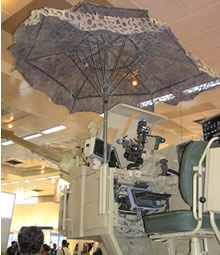
 Artillery precision guided munitions for artillery were represented by a wide range of guided munitions for artillery and mortars, enabling fire units to engage targets with very high precision. The Krasnopol152/155 mm, Kitolov 2M 122mm and Gran 120mm mortar projectiles, which are already in use with the Indian Army.
Artillery precision guided munitions for artillery were represented by a wide range of guided munitions for artillery and mortars, enabling fire units to engage targets with very high precision. The Krasnopol152/155 mm, Kitolov 2M 122mm and Gran 120mm mortar projectiles, which are already in use with the Indian Army.
Responding to the Indian enthusiasm for artillery employment, several companies also promoted advanced dedicated maintenance and support systems for artillery. AGI Ltd from the UK presented the AGICAM, a visual inspection system used for inspecting the barrel bore gauges. The camera is inserted into the barrel and provides either 360 degree peripheral view or a detailed focus on a particular area in more details, by utilizing a 90 deg. Viewing head. The images are sent to the inspection system via wireless link. A different inspection system developed by AGI is the BG20, which monitors the wear along the bore of the gun barrel. Software tools enable filing and storage of measurements by individual barrels, and tracking of specific units approaching or exceeding tube abrasion. Another system, Solclean, was demonstrated by Soltam, The semi automatic cleaning system handles 76-155mm, rifled or smooth bore barrels in 1 – 4 hours, using a special chemical foam for removing copper, brass and normal combustion residues without the use of ammonia or abrasive materials.
DEFEXPO 2004 – Missiles Displays
One of the most impressive weapons at the show was the Indo-Russian Brahmos anti ship missile, designed in a ship launched, submarine launched, coastal launched and air launched versions. A different (subsonic) cruise missile was the Club-S family including the 3M-14E and 3M-54E missiles, displayed by the Russian Novator experimental machine design bureau. MBDA ALSO presented models of its leading products, including the new Exocet MM40 Block 3, currently in full scale development. Advanced torpedoes were also presented here – two of the leading European manufacturers of Torpedoes were presented here, with full scale models of their products. Finmeccanica displayed the Whitehead BlackShark and Atlas Elektronik brought a scaled model of its heavyweight modular Sea Hake Mode 4 which is an evolutionary development the SEA HAKE heavyweight torpedo in as a standard weapon with some of the NATO navies. Other naval products on display included various countermeasures for ships and submarines, including the new SeaPike ASW weapon, and the Siren, presented by BAE.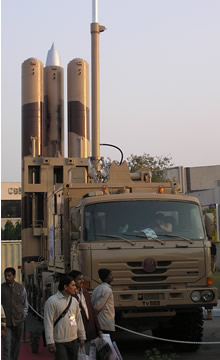
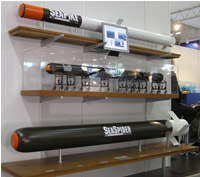 Air defense systems were a common sight at DEFEXPO. MBDA presented two systems – the Mica VL in its land based and naval configurations, and the SAMP/T air defense system, utilizing the Aster 30 missiles. RAFAEL unveiled at DEFEXPO its new concept of “full spectrum solutions”, and chose to demonstrate these solutions with the new SPYDER integrated short range air defense system. Raytheon displayed a model of its SLAMRAAM, The company believes that the US missiles will be suitable for the planned Indian replacements of some of their air defense assets, and provide an adequate answer to an evolving threat of cruise missiles and precision attack weapons. Contraves brought a complete system of the 35mm Skyguard equipped with the AHEAD system while Kentron was ready to discuss some aspects of its Umkhonto missile, encouraged by its success in selling this system to Finish Navy. Russian air defense systems at the show included the 9M317 (SA-11) missile presented by DRPE. This missile is used in the BUK M1-2 land based SAM and with the Naval Shtil-1 system. These missiles are providing a modern replacement for ageing systems such as the SA-6 (which is the Akash missile, locally produced in India), offering enhanced immunity against countermeasures, and effective engagement of faster, smaller targets including cruise missiles and guided weapons. KBP displayed the 9M311 missile, used in the Pantsir S1 mobile air defense system. An upgraded version of this type is also proposed with the Hermes air defense system.
Air defense systems were a common sight at DEFEXPO. MBDA presented two systems – the Mica VL in its land based and naval configurations, and the SAMP/T air defense system, utilizing the Aster 30 missiles. RAFAEL unveiled at DEFEXPO its new concept of “full spectrum solutions”, and chose to demonstrate these solutions with the new SPYDER integrated short range air defense system. Raytheon displayed a model of its SLAMRAAM, The company believes that the US missiles will be suitable for the planned Indian replacements of some of their air defense assets, and provide an adequate answer to an evolving threat of cruise missiles and precision attack weapons. Contraves brought a complete system of the 35mm Skyguard equipped with the AHEAD system while Kentron was ready to discuss some aspects of its Umkhonto missile, encouraged by its success in selling this system to Finish Navy. Russian air defense systems at the show included the 9M317 (SA-11) missile presented by DRPE. This missile is used in the BUK M1-2 land based SAM and with the Naval Shtil-1 system. These missiles are providing a modern replacement for ageing systems such as the SA-6 (which is the Akash missile, locally produced in India), offering enhanced immunity against countermeasures, and effective engagement of faster, smaller targets including cruise missiles and guided weapons. KBP displayed the 9M311 missile, used in the Pantsir S1 mobile air defense system. An upgraded version of this type is also proposed with the Hermes air defense system.
 Two man-portable anti tank missiles shown at DEFEXPO were the Israeli SPIKE MR/LR, and the Raytheon/Lockheed Martin Javelin. Both missiles are competing head to head in several countries, where acquisition of light weight anti-tank systems for infantry units meets priority bids. Through an attractive cooperation with local industries in Europe and Asia, Spike had a head start in Europe – in Finland, Netherlands and Poland, as well as in few undisclosed markets. The missile is also in service in Singapore and Israel. Javelin, widely fielded with the US Army and Marine Corps, won many of the recent competitions – in the UK, Norway, Australia and New-Zealand. Both Javelin and Spike are currently competing on a Canadian Army procurement program. India has yet to decide which missiles are suitable for its future programs. Raytheon sources told Defense Update that so far, Javelin has not been proposed here but the company views the region as an important market for future sales. MBDA has also chosen DEFEXPO as a stage where it previewed its Future Combat Missile System (FCMS), designed for medium and long range engagement of armored targets, by infantry and cavalry units.
Two man-portable anti tank missiles shown at DEFEXPO were the Israeli SPIKE MR/LR, and the Raytheon/Lockheed Martin Javelin. Both missiles are competing head to head in several countries, where acquisition of light weight anti-tank systems for infantry units meets priority bids. Through an attractive cooperation with local industries in Europe and Asia, Spike had a head start in Europe – in Finland, Netherlands and Poland, as well as in few undisclosed markets. The missile is also in service in Singapore and Israel. Javelin, widely fielded with the US Army and Marine Corps, won many of the recent competitions – in the UK, Norway, Australia and New-Zealand. Both Javelin and Spike are currently competing on a Canadian Army procurement program. India has yet to decide which missiles are suitable for its future programs. Raytheon sources told Defense Update that so far, Javelin has not been proposed here but the company views the region as an important market for future sales. MBDA has also chosen DEFEXPO as a stage where it previewed its Future Combat Missile System (FCMS), designed for medium and long range engagement of armored targets, by infantry and cavalry units.
Other anti tank missiles at DEFEXPO 04 included the Russian Kornet-E and the Konkurs-M anti-tank missiles. The later is locally produced in India.
Dutch Digitized Soldier Program D2S2
The Dutch Digitized Soldier System (D2S2) program is under development by the Thales Group. The company was awarded this contract in October 2004. The company will deliver the prototype systems which will be the key components of the future Dutch digitized soldier system. These components are expected to provide the Netherlands’ infantry with a communications infrastructure to meet its future forces’ operational needs.
Thales will provide the soldier radios, central processing computers and control units and dedicated soldier and commander interactive displays which will be operated as an “individual network” integrated into the company chain of command. The system will be linked to the Netherlands Army’s command & control battle management system.
The development is a joint initiative of the Netherlands Ministry of Defense and Thales and will be performed in cooperation with TNO, the Netherlands’ Organization for Applied Scientific Research. Prototype systems will be tested in 2005, with production units planned to go into service in 2006. Thales is already contributing to major soldier modernization programs in the United Kingdom, in Germany and in Norway.
Autonomous Wide Area Search Munition (AWASM)
An Autonomous Wide Area Search Munition (AWASM) is developed by Lockheed Martin for the USAF. The program is integrates a two-way data link in precision guided miniature loitering missile to enable wide area search and destroy. Under the proof-of-concept demonstration the company is integrating a data link into a wide area search munition, to transmit detected target information to a Command & Control (C2) authority and receive engagement authorization for one of the previously detected targets. AWASM will use a Laser Detection and Ranging (LADAR) seeker to automatically determine target aimpoints using demonstrated Automatic Target Acquisition algorithms. The munition will be compatible with F-16, F/A-22, Joint Strike Fighter, B-1 and B-2 aircraft. It will also be able to dispense from a Multiple Launch Rocket System (MLRS) rocket or an Army Tactical Missile System (ATACMS) missile.
Advanced Precision Kill Weapon System (APKWS)
The Low Cost Precision Guided Rocket concept has evolved as a response to a US Army Low-Cost Precision Kill initiative, started in 1996. The idea was simple – strap a laser seeker on a 2.75″ Hydra 70 rocket. Originally, Hydra 70 was originally designed as a family of rockets, used for area suppression, but with additional sophistication, it is transformed into a high precision, low-cost weapon, which provides the precision of a hellfire missile with significantly less collateral damage. The rocket’s blast-fragmentation warhead is also more suitable for urban warfare and low-intensity conflict.
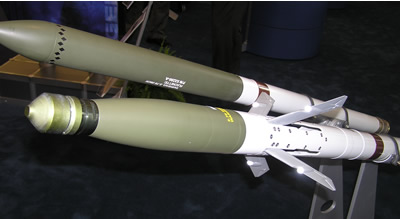 General Dynamics Armament and Technical Products and BAE Systems designed the M151Guided Warhead Block I modification for the 70mm rocket. This warhead retains the same fuse and warhead section of the standard M151, adding a mid-section which includes four semi-active laser seekers are embedded in the wing roots of forward canards, which are used for flight control. The Distributed Aperture Semi-Active Laser Seeker (DASALS) technology utilizes an array of four fixed detectors, which provide the same accuracy at a lower cost, compared to a gimbaled seeker. The complete assembly is emplaced between the warhead and rocket motor assemblies. The modified warhead length is extended from 4.2 cm to 90.9 and increase in weight from 4.2kg to 8.9kg. M151 Block I is currently under development and is scheduled to enter low rate initial production by 2006. Subsequent improvements of other Hydra 70 warheads and elements are planned for future production blocks.
General Dynamics Armament and Technical Products and BAE Systems designed the M151Guided Warhead Block I modification for the 70mm rocket. This warhead retains the same fuse and warhead section of the standard M151, adding a mid-section which includes four semi-active laser seekers are embedded in the wing roots of forward canards, which are used for flight control. The Distributed Aperture Semi-Active Laser Seeker (DASALS) technology utilizes an array of four fixed detectors, which provide the same accuracy at a lower cost, compared to a gimbaled seeker. The complete assembly is emplaced between the warhead and rocket motor assemblies. The modified warhead length is extended from 4.2 cm to 90.9 and increase in weight from 4.2kg to 8.9kg. M151 Block I is currently under development and is scheduled to enter low rate initial production by 2006. Subsequent improvements of other Hydra 70 warheads and elements are planned for future production blocks.
The Guided APKWS technology demonstration program was launched in 2002 and until September 2004 completed five flight tests, hitting targets at ranges of 1,500 to 5,500 meters.
AMAP Protection System
IBD unveiled its new Advanced Modular Armor Protection (AMAP) composite armor concept, follow-on to their combat proven Modular Expandable Armor System (MEXAS) protection, which has provided basic protection suite for over 12,500 combat vehicles worldwide, AMAP, utilizes ultra-fine powders made from nano-particle ceramics to create thinner, lighter but tougher ceramic modules. AMAP is already utilized for a number of new applications including the protection kits for the Italian army’s MLV, the Norwegian CV-9030 and Swedish CV-9040 armored vehicles. New add-on armor suits are on development for Patria’s 8×8 AMV IFV and command vehicles, scheduled for deliveries to the Finnish and Polish armies.













